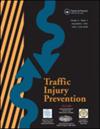通过心率变异性分析研究高速公路隧道入口区的吸引眼球效应。
IF 1.6
3区 工程技术
Q3 PUBLIC, ENVIRONMENTAL & OCCUPATIONAL HEALTH
引用次数: 0
摘要
研究目的本研究旨在通过心率变异性(HRV)指标评估视觉景点条件对驾驶员认知工作量和生理反应的影响。方法:分析心率变异指标,包括 RMSSD、SDNN、LF 和 LF/HF 比率,以评估认知工作量和生理状态。研究收集了每个实验场景下驾驶员的样本数据,并比较了不同条件下的心率变异测量结果:结果:隧道入口视觉景点的存在明显影响了驾驶员的心率变异。视觉景点的引入导致 RMSSD 和 SDNN 值下降,表明认知工作量增加,自律神经系统的适应性降低。此外,视觉景点导致 LF 值和 LF/HF 比值增加,表明交感神经激活和潜在的认知参与增加:视觉吸引力对驾驶员的认知工作量和生理反应有重大影响。要优化驾驶员的认知表现和整体驾驶体验,设计兼顾视觉吸引力和认知需求的隧道入口至关重要。这些研究结果为交通管理部门和设计人员提供了宝贵的见解,以创造更安全、更方便用户的隧道环境。本文章由计算机程序翻译,如有差异,请以英文原文为准。
Investigating the eye-catching effect in the entrance zone of highway tunnels through heart rate variability analysis
Objective
This study aimed to investigate the influence of visual attraction conditions on drivers’ cognitive workload and physiological responses, assessed through heart rate variability (HRV) indicators. The study examined four experimental scenarios, including a baseline condition and three visual attractions (landscape-style architecture, tip slogan, and billboard) at tunnel entrances.
Methods
HRV indicators, including RMSSD, SDNN, LF, and LF/HF ratio, were analyzed to assess cognitive workload and physiological states. The study collected data from a sample of drivers under each experimental scenario and compared the HRV measures across conditions.
Results
The presence of visual attractions at tunnel entrances significantly impacted drivers’ HRV. The introduction of visual attractions resulted in decreased RMSSD and SDNN values, indicating increased cognitive workload and reduced adaptability of the autonomic nervous system. Moreover, visual attractions led to increased LF values and LF/HF ratio, suggesting heightened sympathetic activation and potential cognitive engagement.
Conclusions
Visual attractions have a significant impact on drivers’ cognitive workload and physiological responses. Designing tunnel entrances with a balance between visual attractiveness and cognitive demands is essential to optimize drivers’ cognitive performance and overall driving experience. These findings provide valuable insights for transportation authorities and designers to create safer and more user-friendly tunnel environments.
求助全文
通过发布文献求助,成功后即可免费获取论文全文。
去求助
来源期刊

Traffic Injury Prevention
PUBLIC, ENVIRONMENTAL & OCCUPATIONAL HEALTH-
CiteScore
3.60
自引率
10.00%
发文量
137
审稿时长
3 months
期刊介绍:
The purpose of Traffic Injury Prevention is to bridge the disciplines of medicine, engineering, public health and traffic safety in order to foster the science of traffic injury prevention. The archival journal focuses on research, interventions and evaluations within the areas of traffic safety, crash causation, injury prevention and treatment.
General topics within the journal''s scope are driver behavior, road infrastructure, emerging crash avoidance technologies, crash and injury epidemiology, alcohol and drugs, impact injury biomechanics, vehicle crashworthiness, occupant restraints, pedestrian safety, evaluation of interventions, economic consequences and emergency and clinical care with specific application to traffic injury prevention. The journal includes full length papers, review articles, case studies, brief technical notes and commentaries.
 求助内容:
求助内容: 应助结果提醒方式:
应助结果提醒方式:


